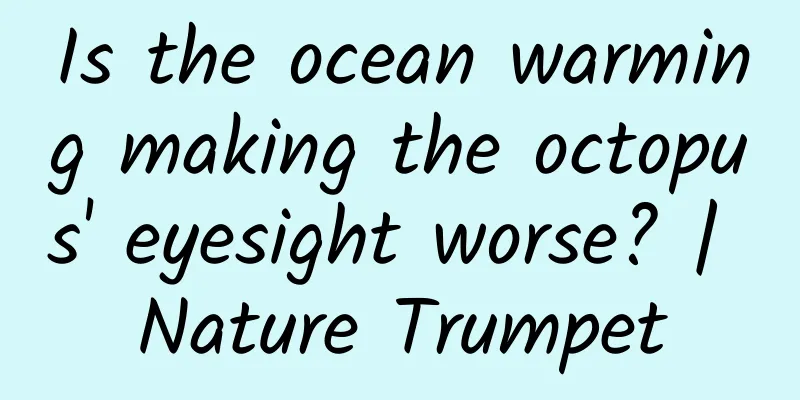Is the ocean warming making the octopus' eyesight worse? | Nature Trumpet

|
Welcome to the 56th issue of the Nature Trumpet column. In the past half month, we have collected the following natural news and research worth reading: 1) The baby killer whale is trapped and rescue is in progress 2) Octopuses’ vision is getting worse because of warming oceans 3) A single fish swimming is noisier than a school of fish 4) Protect corals with straws 5) Blue light pollution is more deadly to birds 6) Scientists discover Voldemort ants Stranded killer whale mother and calf Recently, a mother and daughter killer whale ventured into a shallow channel while chasing a harbor seal and became trapped in a lagoon near Vancouver. The mother killer whale was stranded and died at low tide, and a necropsy revealed that she was pregnant with an unborn killer whale baby. The 2-year-old killer whale that came here with its mother is still alive, but after its mother's death, it has been wandering around and is unwilling to leave. A 2-year-old killer whale is trapped in a lagoon | Chad Hipolito / The Canadian Press / AP The local aborigines named the little killer whale "Kʷiisaḥiʔis", which means "brave little hunter". In order to save the little killer whale and let it return to the open water safely to reunite with its family, a rescue team consisting of 50 people and 6 boats was formed. At first, everyone tried to guide the little killer whale to leave the lagoon on its own, and played the sounds of other killer whales to attract it, but it did not cooperate and still wandered in the lagoon . Therefore, the rescue team changed their strategy and decided to capture the baby killer whale in a net and then transport it to the open sea. However, the baby killer whale still did not cooperate, and it was very smart and quickly adapted to human tactics, so the rescue team could not catch it at all . The rescue team had to suspend the plan, closely monitor the baby killer whale's condition, and try to rescue it again in a few days. Killer whale rescue boat | The Canadian Press While the orca was being rescued, others were looking for its family. The rescue team planned to place the orca in a pen first and then release it when its family passed by, so that it could be reunited with its family . Veterinarians believe that the baby orca is in good health, but it is only two years old and still depends on its mother for many things. Moreover, although there are salmon and perch in the lagoon, people are not sure whether the baby orca has eaten, and the salinity of the lagoon is not suitable for its long-term survival. It is not a long-term solution for it to live here alone. Warming oceans could damage octopus vision As oceans warm, octopuses' vision is getting worse . Like humans, octopuses rely heavily on vision, with 70% of their brains devoted to visual information. They use vision to camouflage themselves, detect the location of prey, and avoid predators. Octopuses change color to camouflage themselves, but they need vision | LASZLO ILYES / Wikimedia Commons In a new study, scientists studied octopuses at different temperatures, including the current temperature (19°C), the summer temperature in recent years (22°C), and the future warming temperature (25°C). The results showed that when the temperature rises, the structural protein in the lens of the octopus eye becomes less , which affects the transparency and optical clarity of the lens; in addition, an enzyme that is essential for the regeneration of visual pigments is also affected by high temperatures. Octopus's eye | Sylke Rohrlach / Wikimedia Commons What is even more worrying is that rising ocean temperatures will also affect the next generation of octopuses . Under 25°C conditions, two of the three octopus nests failed to hatch because the mother octopus died while taking care of the eggs; in the remaining nest, less than half of the baby octopuses successfully hatched, and the mother octopus was always in a state of anxiety. Newly hatched baby octopus | Qiaz Hua If global warming cannot be curbed, as sea temperatures rise, fewer octopuses will be successfully hatched, and the octopuses that survive will find it difficult to see prey and predators, making survival more difficult. Octopuses have a wide range of diets, and when their numbers decrease, other animals in the food chain will also be affected. One fish is noisier than a school of fish A school of mackerel swimming together makes less noise than a single fish! Before this, it was generally believed that the main benefit of fish swimming in groups was to avoid being preyed on. A recent study found that fish swimming together actually has the effect of reducing noise . Demonstration of a fish school swimming model built by researchers | References [3] If every fish in a school moves in unison and flaps its tail at the same time, the sound waves they produce are in phase and will add up, and the total sound will not decrease. However, in a real school of fish, each member is more likely to flap its tail alternately, so the sound waves produced are out of phase and can cancel each other out , and in the end, the sound produced is actually quieter than when a single fish swims. A huge school of fish | OpenStax College / Wikimedia Commons According to the model constructed by the researchers, as long as one fish approaches another fish, there is no need for them to coordinate with each other, and the noise reduction effect begins to take effect. The more fish are added, the better the noise reduction effect. When a large group of fish pass by in a group, if the predator only listens to the sound, it will be fooled and think there is only one fish here . Even more cleverly, while reducing sound, the swinging of the tails of school members can lead to hydrodynamic interactions, generating greater thrust, allowing each fish to swim faster and with less effort . Protecting corals with straws How to protect endangered coral reefs? Scientists have found a new way: insert straws into small corals! Because of rising ocean temperatures, the number of coral reefs around the world is declining, and scientists around the world are trying every possible way - in addition to protecting the original coral reefs, they are also cultivating new corals in the laboratory and then releasing the small corals into the ocean, hoping that they will thrive. Parrot fish that love to eat small corals | Uxbona / Wikimedia Commons However, plans are beautiful, but reality always has unexpected consequences. After the carefully cultivated corals by scientists were transplanted into the sea, they became snacks for fish such as parrot fish. They ate the newly planted corals as popcorn, so that the survival rate of corals was less than 40%. You know, the cost of cultivating a piece of coral is more than $100, and scientists originally planned to plant tens of thousands of corals in the next 10 years. If all of them fall into the mouths of fish, all the efforts and money will be wasted. Small coral protected by a straw | Chris Gug / phade The good news is that fish only like to nibble on newly planted small corals . Once the corals grow up and mature, the fish will lose interest. Therefore, the key to protecting corals is to protect newly planted corals. At first, scientists built metal barriers around the corals, but these barriers needed to be regularly cleaned of algae and eventually had to be removed, which added a lot of work. Finally, they came up with a good idea - inserting degradable straws. Straw fence with no top | Chris Gug / phade The upgraded coral protection measure is a disc surrounded by 8 straws. The fence has no top because the growth of small corals requires sunlight, and this is enough to block fish - they generally don't eat upside down. Scientists chose easily degradable materials. When the corals grow up, the fish lose interest in them, and the straws will degrade almost, and there is no need to remove them manually. Blue light is more deadly to birds Recently, scientists in Singapore found that migrating birds at night are more likely to collide with buildings because of blue light . Blue light pollution is ubiquitous in cities | Frank Schulenburg / Wikimedia Commons Scientists analyzed 225 records of birds hitting buildings between 2013 and 2020 and found that most of the migratory birds that hit buildings were pitta birds. Pitta birds are brightly colored and widely distributed in Southeast Asia. They are more likely to hit buildings because they migrate at night and are particularly sensitive to blue light pollution and are easily attracted by light. Buildings that are still brightly lit at night are a call of death for them. Mangrove Pitta | DChai21. / Wikimedia Commons Among the resident birds, the green pigeon and the green-winged golden pigeon often collide with buildings on the edge of the forest. This is because human cities have fragmented large tracts of forests, and birds will inevitably have to pass through cities when shuttling between forests . Scientists believe that in order to protect these resident birds, buildings located on the edge of the forest and less than 20 meters in height should have anti-collision measures. Green-winged golden dove | Sham Edmond / Wikimedia Commons Every year, hundreds of millions of birds die in North America alone from colliding with buildings. In order to save energy, many areas have replaced street lamps with white LED lamps, but the blue light pollution caused by these lamps is fatal to birds. Scientists suggest that street lamps can be designed with warmer, orange tones to be more bird-friendly. Voldemort Ant Scientists have discovered a species of ants that live underground and have named them Voldemort . Voldemort ant (Leptanilla voldemort sp. nov.) | References [6] These ants do look a bit like the dark wizard Voldemort in Harry Potter and the Deathly Hallows - they are pale, slender, and have a long, pointy chin (and no nose). While Voldemort always hides in the shadows, the Voldemort ants live more than 20 meters underground, nesting and foraging only underground . Voldemort Ant | References [6] Because they live in the dark underground all their lives, Voldemort ants have no pigmentation and cannot see. They are only 1 to 2 mm in size and can easily drill in and out of cracks in the soil. Compared with other ants, their family size is much smaller, and an ant nest generally has only one queen ant and about 100 worker ants. Voldemort ants don't just look like Voldemort, they're probably also terrible hunters, just like Voldemort. Scientists aren't sure what Voldemort ants eat, but their sharp jaws are a sure sign that they're not vegetarians . Their closest relatives use their jaws and spikes to pin centipedes much larger than themselves, and then bring the larvae to eat, so Voldemort ants should have similar predatory skills. Author: Cat Tun Editor: Mai Mai |
<<: One picture to understand: What should you do if a cyst is found during a physical examination?
>>: If you can’t get tickets for May Day, why don’t you add a few more night high-speed trains?
Recommend
iPhone 6 flies against the wind: let all kinds of storms and doors go to hell
It is hard to find another mobile phone like the ...
Google is reportedly developing a standalone VR device that can be used without a PC
Google is developing an all-in-one virtual realit...
Azhe Private Tutor 3.0 "I Know Women's Heart" Full Version
Introduction to Azhe Private Tutor 3.0 "I Kn...
How to do website bidding promotion and how to do it well?
It has been more than a year since I switched fro...
Alibaba’s traffic methodology!
The first thing I want to share is a very mainstr...
A guide to building a Douyin Blue V account matrix!
Douyin's Blue V ecosystem is very complex, an...
Sony Xperia Z1 has a big system evolution but a small appearance change. Price: 4999 yuan
[September 9 news] September is a nightmare for m...
iOS 15 has 7 new features that older iPhones can't use
However, some of the best new features of iOS 15 ...
Have you avoided the 9 minefields of social marketing promotion?
Communities have always been controversial, espec...
From the "reputation-building missile" to Huawei's "reputation-building aircraft", what other "technological breakthroughs" are there on the road to becoming a strong country that you don't know about?
Planning: Little Dandelion, 91 Copywriter: Xiaoxi...
What is happiness? This question has been answered by many people. In fact, Aristotle has already given the answer
© The Collector Leviathan Press: Whenever we talk...
Edmunds: It is estimated that the US new car sales in April 2020 will be only 633,260, a year-on-year decrease of 52.5%
Analysts at Edmunds, a professional American auto...
React Native vs. Kotlin: A Quick Comparison
Mobile applications have become an emerging platf...
Movie "A Clockwork Orange" (A Clockwork Orange) HD English subtitles
Alice (Malcolm McDowell) is a young man who does ...
Help others promote public accounts and make money. How to promote WeChat public accounts?
When it comes to online novels, most people are f...









